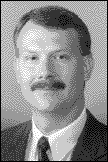From the Executive Director — July and August 2001
From the Executive Director
Diverse issues for a diverse profession
 Tom
Burkgren
Tom
Burkgren
My travels during March and April brought me into contact with some of the diverse segments making up veterinary medicine, as well as the many issues facing the profession.
The national symposium of the Student American Veterinary Medical Association was held in Ames, Iowa in March, and the AASV had a booth in the exhibit area. It was the first time in recent years that we had exhibited as part of this program. The quantity of traffic into the booth could be best described as less than overwhelming! The number of students interested in swine medicine was small.
Most of the veterinary students who stopped by the booth were already members of the AASV. Many wanted to talk about new developments in swine medicine and employment opportunities in the pork industry. A couple even thanked the AASV for including students in membership activities at a reduced cost and for the AASV Foundation scholarship program.
The small number of students interested in swine is consistent with the small number of new graduates taking jobs in animal agriculture.Changes in US demographics are reflected in veterinary medicine. As most of the population moves away from the farm, the profession will no longer be able to rely on the "farm kids" to replenish our ranks. In the future, the AASV will be challenged to encourage students to embarkon careers as swine veterinarians.
Also in March, I participated in a meeting of the Task Force on Veterinary Research organized by the American Veterinary Medical Association (AVMA). This group has been given the charge of discussing and developing a national research agenda for the AVMA. On first blush, this seems a plausible and noble endeavor. However, as you delve into the diverse research needs of the various veterinary sciences and species, you soon realize that this is not something that will be easily accomplished.
The driving force behind the Task Force on Veterinary Research is the decreased funding for most areas of veterinary research. An accompanying problem is the lack of veterinarians going into research. It makes sense that funding is linked to personnel. The value of research is not, however, limited to those performing the research. The livelihood of the entire profession depends on research to some extent.
Getting people, even veterinarians, excited about research can be difficult. Lately, however, the national media have been consumed by two animal-related issues: bovine spongiform encephalopathy (BSE) and foot-and-mouth disease (FMD). Neither is currently occurring in the US, but the threat of introduction is enough to attract the attention of a wide audience. Perhaps now is the opportune time to convince legislatorsand the public of the need for veterinary research.
The threat of FMD was widely discussed at another meeting this spring. The National Institute of Animal Agriculture held its annual meeting in April. This meeting brings together all facets of the food animal industry, including producers, practition-ers, diagnosticians, and both state and federalregulators. Topics for discussion included swine health, animal welfare, pseudorabies eradication, and foreign animal disease. A memorable observation from the meeting is that an immense amount of cooperation and communication will be required if a foreign animal disease such as FMD occurs in the US.
The best defense against any foreign animal disease is to prevent it from entering the US. Short of that goal is the second line of defense, which is an accurate and timely diagnosis followed by complete containment and eradication before spread. The US has an untested system that relies on producers, practicing veterinarians, and veterinary diagnosticians as integral components of an early response. The AASV continues to advocate for increased education and awareness of veterinarians and for increased vigilance in prevention of disease entry. Emergency preparedness is critical for the continuation of animal agriculture in the US.
Preparedness is not an issue for foreign animaldisease alone. Preparedness can also be used to characterize the issue-driven agendas and discussions within an association and a profession. It is preferable to be ready for an issue rather than to be caught unprepared and unguarded when it arises.
An ongoing challenge to the leadership of the AASV is prioritization of current and future issues, which precedes allocation of both financial and human resources. Although leadership is ultimately responsible for this process, it is the members of AASV that provide the drive and initiative to deal with most issues. This has been a strength that has characterized the AASV since its beginnings over 30 years ago. Only the members can sustain this strength for the future. Keep up the good work!
Erratum
I apologize to Schering-Plough Animal Health for omitting recognition of their support of the AASV Annual Meeting in the last issue. Schering-Plough has graciously planned and sponsored the welcoming reception on Sunday evening for several years. This year’s spectacularevent was held at the Wild Horse Saloon. Thank you to Schering-Plough and its personnel for the support.
This page last updated .